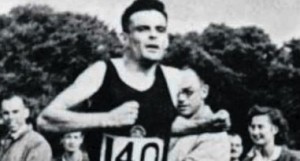
“Somewhere, in that freedom of the open road and the mix of endorphins and exhaustion, Turing found an outlet in running to aid his work”.
We all run for different reasons. Some run because we’re good at it and enjoy the thrill, some because we’re bad at it and enjoy the challenge. But how many people have you heard of who ran to help save the western world? And once he’d done that he laid down the foundations for the technological revolution, using running all along to clear his mind, focus his thoughts and explore the inner workings of a fiercely unique mind.
Alan Turing, the renowned solver of World War Two’s Enigma and oft-regarded father of modern computing was a high-class distance runner and a man for whom running was a passion. This is something that our fraternity should really make more of. One of the great minds of our age who used his brilliance to fight the evil of Nazism and create the basis for computers, used running as his tool. You can’t buy marketing like that.
Turing, who has been widely celebrated in his centenary year, had an imagination and creativity that let him tackle the biggest problem of his age. As a young man this was the threat of Hitler’s Germany overtaking Europe and, from there, the world. With his native Britain under threat the maths whiz-kid was hired by the British government to break the codes that Germany was using to organize their war effort. From the intelligence complex of Bletchley Park to London is a distance of sixty kilometers and the Turing myth holds that he would run the distance to get to various meetings.
“He was stocky with a great barrel chest,” describes Alan Garner who was his early running partner. “It was strange to see him run because he didn’t run, he was hammering into the road. He was running into the road, not over it.”
With the war effort won, in large part due to his efforts, Turing turned some of his energies towards middle distance running and made an instant mark with fast middle distance times and some notable performances against and, on occasion, in front of Olympic medalists. As one would imagine of a mathematical genius, Turing methodically worked his way up in distance and ability to the marathon and had his sights set on representing Britain at the 1948 Olympics, to be held in his home city. While much is made of his near-miss of Olympic selection in reality he was well off the pace, although his time of 2.46 would have qualified him in previous years and ranked him in 9th position across Britain for the year.
To the humble soul it is difficult to imagine just what Turing created and the machinations of his mind. He invented various computer programmes, including the Colossus which worked its way through the 159 million million million possible combinations of the German code system to find a solution. In 1945 he came up with the Automatic Computing Engine which was the first, and highly advanced, computer and it is said that the language and visions of computing that he created are the foundations of the digital age.
He was an expert in logarithms, formula and method, intensely mental processes that need to be worked out through a mixture of mental process and inspiration. Somewhere, in that freedom of the open road and the mix of endorphins and exhaustion, Turing found an outlet in running to aid his work. “He was using running to think,” says Garner who fondly remembers their time running and their joint love of the absurd. None of his running partners knew of the national importance that their eccentric running partner held due to the secrecy of his work and Turing kept his working and running lives separate. The clarity that his body and mind found in running, however, was the fuel not only for his love of the sport but also for the visionary insights he created and fed.
Sadly Turing’s life turned from being a humble hero into a horror story. His racing career was ended by a bad fall although he continued to run for enjoyment. He failed to obtain much of that, however, as he was arrested and charged in 1952 for homosexuality and forced to undergo chemical sterilization: the taking of estrogen to forcefully inhibit his libido and render him impotent. The side effect of lethargy and apathy sucked his love of running out of him and one of the world’s finest minds took his own life at the age of 41 with a dose of cyanide washed down with the bite of an apple. It was a symbolic gesture from a man who marveled at the Snow White story and the fragility of life and death, but the second half of the century lost a man who loved to run and used it as a tool to better mankind.
Story by Trail Run Mag Barefoot/Minimalist (and now historical) Editor, Garry Dagg







